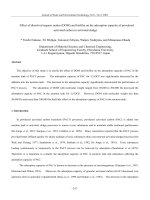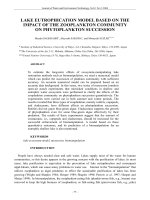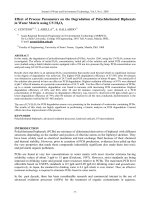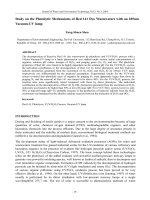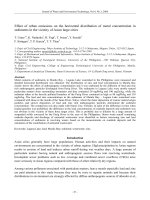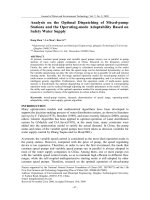NATIONAL REPORT OF MALAYSIA ON THE FORMULATION OF A TRANSBOUNDARY DIAGNOSTIC ANALYSIS AND PRELIMINARY FRAMEWORK OF A STRATEGIC ACTION PROGRAMME FOR THE BAY OF BENGAL potx
Bạn đang xem bản rút gọn của tài liệu. Xem và tải ngay bản đầy đủ của tài liệu tại đây (1.01 MB, 88 trang )
UNITED NATIONS ENVIRONMENT PROGRAMME
EAST ASIAN REGIONAL COORDINATING UNIT
N
N
A
A
T
T
I
I
O
O
N
N
A
A
L
L
R
R
E
E
P
P
O
O
R
R
T
T
O
O
F
F
M
M
A
A
L
L
A
A
Y
Y
S
S
I
I
A
A
O
O
n
n
t
t
h
h
e
e
F
F
o
o
r
r
m
m
u
u
l
l
a
a
t
t
i
i
o
o
n
n
o
o
f
f
a
a
T
T
r
r
a
a
n
n
s
s
b
b
o
o
u
u
n
n
d
d
a
a
r
r
y
y
D
D
i
i
a
a
g
g
n
n
o
o
s
s
t
t
i
i
c
c
A
A
n
n
a
a
l
l
y
y
s
s
i
i
s
s
A
A
n
n
d
d
P
P
r
r
e
e
l
l
i
i
m
m
i
i
n
n
a
a
r
r
y
y
F
F
r
r
a
a
m
m
e
e
w
w
o
o
r
r
k
k
o
o
f
f
a
a
S
S
t
t
r
r
a
a
t
t
e
e
g
g
i
i
c
c
A
A
c
c
t
t
i
i
o
o
n
n
P
P
r
r
o
o
g
g
r
r
a
a
m
m
m
m
e
e
f
f
o
o
r
r
t
t
h
h
e
e
B
B
a
a
y
y
o
o
f
f
B
B
e
e
n
n
g
g
a
a
l
l
C O N T E N T S
Page
Chapter 1 : NATIONAL REPORT OF MALAYSIA ON THE BAY OF
BENGAL LARGE MARINE ECOSYSTEM PROGRAMME
1
1. INTRODUCTION 1
1.1
AIM OF REPOR T 1
1.2
MAJOR WATER-RELATED ENVIRONMENTAL
PROBLEMS
1
1.2.1 Air-Related Environmental Problems 2
1.3
COUNTRY BACKGROUND 4
Chapter 2 :
DETAILED ANALYSIS OF MAJOR WATER-RELATED
CONCERNS AND PRINCIPAL ISSUES
15
2.1
POLLUTION 15
2.1.1 Rivers 15
2.1.2 Sedimentation 17
2.1.3 Industrial Waste 17
2.1.4 Domestic Waste 18
2.1.5 Agricultural and Livestock Waste 19
2.1.6 Heavy Metals 20
2.2
MARINE POLLUTION 20
2.2.1 Ports, Harbours and Marine Transport 20
2.2.2 Small Vessel Operation and Discharge 22
2.2.3 Aquaculture Effluents 23
2.2.4 Domestic Discharge from Coastal Population 23
2.2.5 Land Reclamation 25
2.3
FRESHWATER SHORTAGE AND DEGRADATION OF
QUALITY
26
2.3.1 Surface Water 26
2.3.2 Surface Water Demand and Supply 26
2.3.3 Groundwater 28
2.3.4 Water Related Issues and Problems 29
2.3.5 Sensitive and High Risk Areas 31
2.4
EXPLOITATION OF LIVING AQUATIC RESOURCES 32
2.4.1 Living Freshwater Resources 35
2.4.2 Living Marine Resources 38
2.4.2.1
Marine Capture Fisheries 38
2.4.3 Impact of Man-based Activities on Freshwater and 49
Marine Ecosystems
Chapter 3 :
ANALYSIS OF SOCIO AND ECONOMIC COSTS OF
IDENTIFIED WATER-RELATED PRINCIPAL
ENVIROMENTAL ISSUES
51
Chapter 4 :
ANALYSIS OF THE ROOT CAUSE OF IDENTIFIED
WATER-RELATED ISSUES
55
i
C O N T E N T Page
Chapter 5 :
CONSTRAINTS TO ACTION 58
5.1
INSTITUTIONAL PROBLEMS 58
5.2
LACK OF CAPACITY TO IMPLEMENT POLICIES AND
ENFORCE REGULATIONS
59
5.3
INADEQUATE CENTRAL SEWAGE SYSTEM AND
TREATMENT FACILITIES
60
5.4
INTEGRATED RIVER BASIN MANAGEMENT (IRBM)
APPROACH
61
5.5
PUBLIC AWARENESS ON WATER CONSERVATION 62
5.6
COASTAL POLLUTION 63
5.7
INTEGRATED COASTAL ZONE MANAGEMENT (ICZM)
64
Chapter 6 :
ONGOING AND PLANNED ACTIVITIES RELEVANT TO
IDENTIFIED ISSUES
65
6.1 INSTITUTIONAL 65
6.2 LACK OF CAPACITY TO IMPLEMENT POLICIES AND
ENFORCE REGULATIONS
66
6.3 INADEQUATE CENTRAL SEWAGE SYSTEM AND
TREATMENT FACILITIES
66
6.4 LACK OF PUBLIC AWARENESS 68
Chapter 7 :
TRANSBOUNDARY ISSUES, KNOWLEDGE GAPS, AND
RECENT DEVELOPMENTS
69
7.1 POLLUTION 69
7.2 EXPLOITATION OF MARINE RESOURCES 73
7.3
COASTAL LAND RECLAMATION
74
7.4
HIGH DEMAND FOR MARINE PRODUCTS
75
7.5
KNOWLEDGE GAPS
76
7.6
RECENT DEVELOPMENTS
77
References
ii
L I S T O F T A B L E S Page
1.1 : General Economic Data, Malaysia (2002) 6
1.2 : Major Export Items, Malaysia (2002) 8
1.3 : Major Export Markets by Country (2002) 8
1.4 : Major Import Items, Malaysia (2002) 9
1.5 : Major Import Sources by Country, 2002 9
2.1 : Status and Trend of River Water Quality, Malaysia, (1988-1994) 16
2.2 : Distribution of Major Industrial
Sources of Water Pollution, West Coast States (1993)
18
2.3 : Malaysia: Organic Pollution Load Discharged According to Sector
(1989 –1993)
19
2.4 : Number of Vessel by Major Ports in the Straits of Malacca (2001-2002) 21
2.5 : Oil Spill Incidents in Malaysia Water Year 1975-1997 22
2.6 : Population by State, West Coast Malaysia (2000) 24
2.7 : Domestic and Industrial Water Demand, West Coast (1980-2000) 27
2.8 : Inshore Vs Offshore landing (tonnes), West Coast Malaysia (1990 – 2000) 34
2.9 : Freshwater Culture Systems by Species 36
2.10
: Fish Species Landings by Location, Malaysia (2000) 38
2.11
: Number of Licensed Fishing Vessels by Tonnage Class,
West Coast Malaysia (1980 – 2000)
43
2.12
: Aquaculture Resource Potential in Malaysia 45
2.13
: Aquaculture Production from Brackish/Marine Aquaculture Systems,
West Coast Peninsular Malaysia (2000)
45
2.14
: Mangrove Reserves and State Land Mangroves in Peninsular Malaysia 47
2.15
: Summary of Adverse Impacts of Man-based Activities On the Marine and
Freshwater Ecosystems
50
3.1 : Endangered Marine Resources and Mortality Sources 54
4.1 : Analysis of Root Causes and Socio-Economic Impacts of Water-Related
Issues - (a and b)
56
iii
L I S T O F F I G U R E S Page
1.1
: Map of Study Area 8
1.2
: Temporal Monsoons Affecting Peninsular Malaysia 12
2.1
: Number of Fisherman Working in Licensed Vessels
West Coast Peninsular Malaysia, 2000
33
2.2
: Composition of Marine Fish Species Group Landings, West Coast
Peninsular Malaysia (2000, 1980, 1990)
41
2.3
: Contribution by Gear Group to Total Landing, West Coast Peninsular
Malaysia (2000)
43
3.1
: The Socio-Economic Costs of Water Resource Degradation
52
iv
NATIONAL STUDY TEAM
PRINCIPAL AUTHOR
Prof. Ishak bin Haji Omar (PhD)
Professor, Faculty of Economics and Management
University Putra Malaysia
43400 Serdang, Selangor, Malaysia
Email:
Tel: +6012 3793 047
TECHNICAL ADVISOR
Fauzy Abdullah
Capital Risk Management Sdn Bhd
E703, Phileo Damansara
46350 Petaling Jaya, Selangor, Malaysia
Email:
Tel: +603 7660 7272
RESEARCH ASSISTANT
Soffie, W.M.
Capital Risk Management Sdn Bhd
E703, Phileo Damansara 1
46350 Petaling Jaya, Selangor, Malaysia
Email:
Tel: +603 7660 7272
v
ACKNOWLEDGEMENT
The author wishes to express his sincere gratitude to the following individuals for
providing valuable literature and spending time for an interview;
1. Y.B. Dato’ Dr. Hashim Hassan Secretary-General II
Ministry of Science, Technology and
Environment, Putrajaya, Malaysia.
2. Dr. Mohd Zahit b. Ali Director
Conservation and Environment Division,
Ministry of Science, Technology and
Environment, Putrajaya, Malaysia
3. Mr. Lee Choong Min Director
River Division
Department of Environment
Ministry of Science, Technology and
Environment, Putrajaya, Malaysia
4. Dr. K. Kuperan Viswanathan ICLARM
The World Fish Centre
Penang, Malaysia
5. Prof. Dr. Mohd Ibrahim Hj.
Mohamed
Professor
Faculty Science and Environmental
Studies
UPM, Serdang, Malaysia
vi
UNEP/SCS – National Report Malaysia
1
NATIONAL REPORT OF MALAYSIA ON THE
BAY OF BENGAL LARGE MARINE
ECOSYSTEM PROGRAMME
By
Ishak Haji Omar
*
1. INTRODUCTION
1.1 AIM OF REPORT
The aim of the national report is to review existing information on the use of, and
threats to, the Malaysian coastal and marine resources off the Straits of Malacca and the
adjacent waters of the Andaman Sea and the Indian Ocean. In the process, an attempt is made
to identify, examine, and rank those threats that have transboundary effects on man and the
environment and to determine information gaps that need to be addressed for integrated
management of coastal and marine resources in the region.
1.2 MAJOR WATER-RELATED ENVIRONMENTAL PROBLEMS
The sources of water-related environmental problems in Malaysia are both land and
sea-based pollution. The fouling of the water ecosystem, natural or man induced, cause
delirious effects such as harm to living resources, hazards to human health, and a hindrance to
economic processes.
Land-based Sources of Pollution
One of the main causes of water/river pollution is the rapid urbanisation on the West
Coast, arising from the development of residential, commercial, and industrial sites,
infrastructural facilities (ports and roads) as well as land reclamation in coastal waters. The
*
Professor, Faculty of Economics and Management, University Putra Malaysia, 43400 Serdang, Selangor,
Malaysia. The author takes responsibility for the views expressed in the paper.
UNEP/SCS – National Report Malaysia
2
destruction of rainforests and water catchments, and the subsequent erosion of soils together
with the heavily silted run-offs, pollutes the rivers. These and other sources of land-based
pollution are as follows:
• Sediment run-off
• Industrial waste
• Domestic waste
• Agricultural and animal waste
• Heavy metals
Sea-based Sources of Marine Pollution
Next to the Dover Straits in U.K., the Straits of Malacca is the world’s second busiest
international shipping lane. Over 15,000 vessels, large and small, utilize the straits waters
daily. Shipping activities, discharges, and accidents are all threats to the marine environment.
In general, the sea-based sources of marine pollution in the coastal waters off the West Coast
of Peninsular Malaysia are:
• Shipping activities (operational discharge, deballasting, tank cleaning,
bilge water and sludge)
• Small vessel discharge (barges and fishing vessels)
• Aquaculture development (prawn and fish culture)
• Domestic discharge from coastal population
• Land reclamation (for commercial/industrial centres)
1.2.1 Air-Related Environmental Problems
Though not directly a water related environmental problem, the haze in 1997 caused
by Indonesia’s shifting agriculture and slash-and-burn technique of jungle clearing was one
of Asia’s worst man-made catastrophe. The emission of smoke, soot, organic particles and
UNEP/SCS – National Report Malaysia
3
noxious gases such as nitrous oxides, sulphur oxides, dioxins, and other volatile compounds
sent the air pollution index in neighbouring Southeast Asian countries beyond the very
unhealthy (201-300) and, for some areas, above the hazardous (>500) level.
Haze is a phenomenon characterised by visibility impairment due to the scattering and
absorption of light by particles and gases in the atmosphere. Its effect to the water
environment is through:
• Emissions of sulphur dioxide (SO
2
) and oxides of nitrogen (N0
x
) and related
particulate matter (sulphates and nitrates) that contribute to poor visibility and
impact public health that in form is associated with breathing difficulties,
damage to lung tissue, cancer and premature death.
• Acid rain, as emissions of SO2 and N0x in the atmosphere react with water,
oxygen and oxidants to form acidic compounds. The acid rain raises the acid
levels of lakes and streams making the water unsafe for some fish and other
wildlife.
Indonesian haze has hit the region on a number of occasions in the 1980’s and 1990’s.
The one in 1977 was the worst incurring an economic loss of US1.3 billion, from close-down
of factories, curtailing of regional flights, drop in tour packages, to vessel accidents in the
Straits of Malacca (www.icsea.org/sea-span).
With Malaysian companies investing in a big way in palm plantations in Kalimantan
and Sumatra and with palm oil prices expected to be bullish, the torching of forest lands in
Indonesia could be on an industrial scale in the future. The monitoring, control, and
management of Indonesian haze has to be on a regional basis among ASEAN members.
Being hit by the ASEAN financial crisis, Indonesia is not in a position to adopt the polluter-
pays principle.
UNEP/SCS – National Report Malaysia
4
1.3 COUNTRY BACKGROUND
General Geography
Malaysia is situated in the central part of South-East Asia and occupies a total land
area of 330,434 square kilometres. The land mass comprises three main components:
Peninsular Malaysia and the two states of Sabah and Sarawak, which occupy the coastal strip
of northwest Borneo (Figure 1.1). Peninsular Malaysia is the largest of the three areas,
covering 131,387 square kilometres.
Figure 1.1: Map of Study Area
Malaysia has a long coastline of 4,810 km. Her marine waters consist of a continental
shelf of 148,307 km
2
and an Exclusive Economic Zone of 450,000 km
2
.
Economic Setting
Malaysia consists of a federation of 11 states in Peninsular Malaysia and the states of
Sabah and Sarawak in the north of Kalimantan. Kuala Lumpur, the national capital, Labuan
UNEP/SCS – National Report Malaysia
5
and Putra Jaya form the Federal territories. The multiracial population of Malaysia is
composed of 58 percent bumiputra (Malays and indigenous people), 24 percent Chinese, and
the remainder Indians and other minor groups (18 per cent). The population was about 22
million in 2002, with the majority (over 80 per cent) living in Peninsular Malaysia.
Under the Federal Constitution, both land and water are state matters, while public
health and sanitation are concurrent matters on which both can legislate. To some extent, the
federal and state jurisdiction overlaps in environmental management, whereby broad policies
are formulated at the national level for implementation by the respective federal and state
agencies at the ground level. This overlapping of roles and responsibilities at the
implementing level can lead to unnecessary bureaucracy, agency rivalry and slow action.
In Peninsular Malaysia, the 11 states can be divided into two economic regions. The
majority of the manufacturing industries, plantations, tin reserves, ports and populations are
concentrated in the west coast states, while the east coast states are sparsely populated and
relatively undeveloped.
The general data on the Malaysian economy are shown in Table 1.1. With a gross
National Product (GNP) of RM310.8 billion and a GNP per capita of RM13,361 (US$3,516),
Malaysia enjoys a reasonable standard of living with low poverty (9.6 per cent of households)
and unemployment rates (3 per cent).
Since independence in 1957, the structure of the Malaysian economy progressed from
a simple agriculture economy to one that is industrial and export-oriented economy.
Subsequently, the share of agriculture dropped from 29 per cent in 1970 to 14 per cent in
2000, while the share of manufacturing jumped from 14 per cent in 1970 to27.8 per cent for
the same period (Dept. of Statistics, 2002).
UNEP/SCS – National Report Malaysia
6
Table 1.1: General Economic Data, Malaysia (2000)
Area
329.758 sq km
(incl. inland water) 330,417 sq km
(Peninsular) 131,598 sq km
(Sabah) 73,711 sq km
(Sarawak) 124,449 sq km
Poverty rate 9.6% of households
GDP RM339.4 billion
GNP RM310.8 billion
GNP per capita RM13,361
Current Account Balance +RM31.2 billion
Exports / imports RM373.3 bn / RM312.4 billion
CPI change +1.5% (Q1 2001)
Employment
9.64 million
Agriculture = 14.0%
Mining = 00.5%
Manufacturing = 27.8%
Construction = 08.8%
Services = 48.3%
Unemployment 3.0%
Water coverage 91% of population
Sources: Department of Statistics, Malaysia.
UNEP/SCS – National Report Malaysia
7
Table 1.2 shows the major export items of Malaysia in 2002, both in terms of value
and share. Electrical and electronic, palm oil, petroleum, and wood-based industries
contributed over 75 per cent to total export value.
In terms of export markets, Singapore, USA, and Japan were the main trading partners
(Table 1.3). Together, these countries imported merchandise worth about RM27 billion and
accounted almost 50 per cent of Malaysian exports.
Malaysian imports consist mainly of intermediate raw materials and equipment for her
value-added manufacturing activities (Table 1.4). These include mainly electrical and
electronic materials, machinery appliance and parts, metals and iron and steel products.
Similar to export markets, her major import sources were from Japan, USA and Singapore
(Table 1.5).
Study Area
Peninsular Malaysia comprises mainly of highlands, floodplains, and coastal zones.
The mountain range, Banjaran Titiwangsa, which runs from north to south divides the west
coast and east coast states of the Peninsular. Starting from the north, the west coast states that
fringe the Straits of Malacca are Perlis, Kedah, Penang, Perak, Selangor, Negeri Sembilan,
Malacca, and West Johore (Figure 1).
Most rivers on the west coast of Peninsular Malaysia such as Sg. Muda, Sg. Pinang,
Sg. Perak, and Sg. Klang are short and steep. Open water bodies, natural wetlands, and man-
made lakes such as dams, and ex-mining pools are mostly found in the Klang and Kinta
Basins. These water bodies are used for power generation, flood control, national water
supply, recreation, aquaculture and tourism.
UNEP/SCS – National Report Malaysia
8
Figure 1.1: Map of Study Area
Table 1.2: Major Export Items, Malaysia (2002)
Value
(RM Million)
Share
(%)
Electrical and electronic 197,986.6 55.9
Palm oil 17,193.2 4.9
Chemical 16,731.9 4.7
Crude petroleum 11,831.8 3.3
Machinery appliances & parts 11,150.5 3.1
LNG 10,451.4 2.9
Wood products 10,451.4 2.9
Textiles and clothing 8,408.3 2.4
Optical and scientific 8,157.3 2.3
Refined petroleum 6,790.1 1.9
Source: Department of Statistics, Malaysia.
Table 1.3: Major Export Markets by Country (2002)
Value (RM Million Share
(%)
USA 71,501.9 20.2
Singapore 60,663.5 17.1
Japan 39,776.3 11.2
Hong Kong 20,169.3 5.7
China 19,965.8 5.6
Thailand 15,096.0 4.3
Taiwan 13,223.9 3.7
Netherlands 13,146.9 3.7
Korea Republic of 11,823.7 3.3
United Kingdom 8,353.1 2.4
Source: Department of Statistics, Malaysia.
UNEP/SCS – National Report Malaysia
9
Table 1.4: Major Import Items, Malaysia (2002)
Value
(RM Million)
Share
(%)
Electrical & electronic 149,469.8 49.2
Machinery appliance & parts 26,659.2 8.8
Chemical 21,525.0 7.1
Manufactures of metal 11,004.7 3.6
Transport equipment 11,540.1 3.8
Iron and steel products 9,746.9 3.2
Optical and scientific 9,139.2 3.0
Refined petroleum 7,496.3 2.5
Crude petroleum 4,780.1 1.6
Textiles and clothing 4,319.9 1.4
Source: Department of Statistics, Malaysia.
Table 1.5: Major Import Sources by Country, 2002
Value
(RM Million)
Share
(%)
Japan 53,909.6 17.8
USA 49,699.8 16.4
Singapore 36,316.1 12.0
China 23,474.4 7.7
Taiwan 16,803.5 5.6
Korea Republic of 16,079.4 5.3
Thailand 12,017.0 4.0
Germany 11,163.4 3.7
Philippines 9,862.8 3.2
Indonesia 9,688.0 3.2
Source: Department of Statistics, Malaysia.
UNEP/SCS – National Report Malaysia
10
Marine Environment
Covering both the continental shelf and exclusive economic zone, Malaysian maritime
waters off the West Coast of Peninsular Malaysia is approximately 600 nautical miles long,
semi-conical in shape, with widths of 220 nautical miles in the northwest and 8 nautical miles
at the Riau Archipelago. A major portion of the waters lies within the continental shelf areas
of 10 to 60m in depth. The deepest area (70m) is in the Andaman Sea at the northern tip of
the Straits, while the shallowest is at the One Fathom Bank in the south.
The current predominantly flows in a northwest direction with rates of 1 to 1.25 knots,
although in some areas it may increase to 5 knots. The tidal range varies from 1.6 to 3.7
meters, with a much higher range inshore. For instance, Port Klang has experienced tides of
up to 5 meters and with a tidal stream of over 4 knots.
The West Coast of Peninsular Malaysia has an equatorial climate, with an average
annual rainfall of more than 2500mm and a daily temperature that ranges from a minimum of
25°C to a high of 33°C. The area is subjected to two rainy spells, the Southwest monsoon
from June to September and the Northeast monsoon from November to March (Figure 1.2).
During these periods, the marine waters may be rough enough to curtail fishing operations in
the Straits.
The coastal zone along the Straits of Malacca is rich in mangroves, estuaries, coral
reefs, sea-grass meadows and algae beds, mudflats, beaches and small island ecosystems.
Each of these marine-based resources, with its unique habitat, supports a wealth of marine
life, some not well explored nor documented.
UNEP/SCS – National Report Malaysia
11
Figure 1.2 Temporal Monsoons Affecting Peninsular Malaysia
I) South West Monsoon II) North East Monsoon
Pollution Control and Management
The main legislation protecting the environment in Malaysia is the Environmental
Quality Act (EQA), 1974. The legislation sets limits to allowable pollutant levels for both
land and sea-based sources as well as for prescribed development activities as specified under
the Environmental Impact Assessment Regulations (1987). There are other regulations to
complement the Environment Quality Act, 1974, such as laws governing resource use
(National Forestry Act, 1984, Fisheries Act, 1985, and Exclusive Economic Zone Act, 1984),
vessel operation and conduct (The Merchant Shipping Ordinance, 1952), land use pattern
(National Land Code, 1965, and Land Conservation Act, 1960), and other local government
by-laws on earthworks, earth removal, mining, sanitation and solid waste disposal.
Thus, with respect to water resources, the most important legislation in Malaysia
governing water quality management is the Environmental Quality Act (EQA), 1974. The
objective of the EQA is basically twofold: pollution prevention, abatement and control as
UNEP/SCS – National Report Malaysia
12
well as environment enhancement. There are at least six sets of regulations under EQA, 1974,
for control of water pollution and the environment, and these are:
• Environmental Quality (Prescribed Premises)(Crude Palm Oil Regulation,
1974)
• Environmental Quality (Prescribed Premises)(Law Natural Rubber)
Regulation, 1979.
• Environmental Quality (Sewage and Industrial Effluents) Regulations, 1979.
• Environmental Quality (Prescribed Premises)(Schedules Waste Treatment and
Disposal Facilities), Regulations, 1989.
• Environmental Quality (Scheduled Wastes) Regulations, 1989.
• Environmental Quality (Prescribed Activities Environmental Impact
Assessment) Order, 1987.
The above regulations stipulate the standards and procedures for handling the various
types of domestic and industrial wastes.
Stakeholders and Water Resource Management
The conservation, use, and management of water resources, freshwater or marine, is
everyone’s concern. The general public, private sector, national and local governments, non-
governmental organizations, and international agencies have a role and responsibility to
ensure proper and sustainable use of water resources.
In Malaysia, the administration and management of water resources is carried out by
Federal and various state government agencies. The Federal Government sets the policies and
undertakes studies at the national level for overall planning and development purposes.
Recently, the Federal Government initiated the National Water Resource Studies (till year
2050) and established the National Water Resource Council (1998) with the responsibility of
streamlining water resource development and management activities of all states.
UNEP/SCS – National Report Malaysia
13
As mentioned earlier, the relationship between the states and Federal Government in
terms of legislative and executive powers is governed by the Federal Constitution. Under the
Constitution, land is a state matter and, hence, state governments have legislative powers over
rivers, lakes, streams, aquifers, including turtles and riverine fishing. The key agencies that
deal with the implementation, management and monitoring of water resources include the
following: -
• Department of Irrigation and Drainage (under the Ministry of
Agriculture)
Involves in development works, operations, and maintenance of water
supply and infrastructures. Also, provides other technical services such
as flood control, coastal pollution information, hydrological data
collections, irrigation and river conservancy.
• Department of Environment (DOE) (under Ministry of Science,
Technology and Environment)
Mission is to promote, ensure and sustain sound environmental
management in the process of nation building. Has responsibility to
ensure the water in rivers is clean by controlling and monitoring
pollution. Also undertakes mitigated measures through implementation
of the Environmental Impact Assessment (EIA) for projects.
• State Water Departments
State agencies are responsible for water abstraction, treatment, and
distribution to consumers and industrial users.
• Local Authority
The local authorities indirectly influence the state of rivers and water
resources through their overall development plans and land use
decisions.
• Department of Town and Country Planning (Ministry of Local
Government)
Controls land use patterns and pace of development as the Department
gives the final approval to developers. Land-use zoning directly affects
river and water resources.
• Forestry Department
Responsibility to manage state gazetted forests, peat wetlands and
mangrove forests as well as catchment areas and rivers within forests. It
also controls logging activities through the selective management system
(SMS).
UNEP/SCS – National Report Malaysia
14
Besides the state and federal agencies, some of the local community groups and
NGOs that are active on environmental issues include: Friends of the Earth (Sahabat Alam
Malaysia), World Wildlife Fund for Nature (Malaysia), Malaysian Institute of Marine Affairs
(MIMA), Malaysian Nature Society, Malaysian Fisheries Society, Environmental Protection
Society of Malaysia, Public Media Club, and various charity organizations.
Malaysia participates actively in the regional and international fora on environment
and has good working relationships with a number of international organizations. Some of
these linkages include United Nations Environmental Programme (UNEP), United Nations
Conference on Environment and Development (UNCED), Food and Agriculture Organization
(FAO), Coordinating Body on the Seas of Asia (COBSEA), UNESCO, GEF/UNDP/IMO,
and PEMSEA.
UNEP/SCS – National Report Malaysia
15
2. DETAILED ANALYSIS OF MAJOR WATER-RELATED
CONCERNS AND PRINCIPAL ISSUES
2.1 POLLUTION
Often associated with the flow of residuals, pollution can be defined as the presence
of matter or energy that has undesired effects on the environment. Pollutants pose a risk to
life support ecosystems and can be difficult to control. Water pollutants are many, if not
more than their polluting sources.
2.1.1 Rivers
Rivers with their loads of municipal, industrial and agricultural wastes eventually end
up discharging these at the estuaries and polluting the coastal marine waters. Under the
previous Malaysian Water Quality Programme, a total of 116 rivers encompassing 892
sampling stations were monitored by the Dept. of Environment throughout the country.
Assessment of water quality in these stations were measured in terms of biological and
chemical characteristics and compared against the national water quality standards.
Table 2.1 shows the status and trend of river quality for the period 1988-1994. It can
be seen from the water quality measured in terms of Biological Oxygen Demand (BOD)
caused by organic decomposition, ammoniacal nitrogen (NH
3
-N) emitted from sewage and
animal waste, and suspended solids from soil erosion and sedimentation all registered
negative overall trend (deteriorated) for the period 1988-1994. The overall water quality
index, measured for its physical, chemical and biological characteristics in form of turbidity,
salinity, temperature, pH, dissolved oxygen and electrical conductivity, also worsened for all
116 rivers over the same period.
UNEP/SCS – National Report Malaysia
16
Table 2.1: Status and Trend of River Water Quality, Malaysia, (1988-1994)*
Status in 1994
Pollutants
Polluted Slightly Clean
Overall Rate of Change
(1988-1994)
Biological Oxy.
Demand (BOD)
13
(13%)
18
(15%)
83
(72%)
-0.88
Deteriorated
Suspended Solids
(SS)
66
(57%)
16
(14%)
34
(29%)
-0.91
Deteriorated
Ammonia cal
Nitrogen (NH
3
-N)
36
(31%)
35
(30%)
45
(39%)
-1.72
Deteriorated
Overall Water
Quality Index
(WQI)
14
(12%)
64
(55%)
38
(33%)
-0.92
Deteriorated
* A total of 116 rivers were evaluated.
Source: Dept. of Environment Malaysia (1994).
From the table, suspended solids and ammoniacal nitrogen were the main pollutants
accounting for 57 per cent and 36 per cent of the total polluted rivers respectively.
Since 1995, there were no documented statistics on river water assessment that was
published by the DOE, as the Natural Water Quality Programme was contracted to a private
company, Alam Sekitar Malaysia Sdn Bhd (ASMA). However, in 2000 the DOE resumed the
data collection but the format was changed from river to basin-based reporting, depriving
inter-period comparisons. This time around, the DOE covered 931 water-monitoring stations
which were located within 120 river basins (DOE, 2001). Of these 931 monitoring stations,
489 (53%) were found to be clean, 303 (33%) slightly polluted, and 135 (15%) polluted.
Even though the outcomes are not exactly comparable to those of 1994, because of sample
size and location of stations, nonetheless the broad picture indicates a general improvement
in water quality of the Malaysian rivers. This improvement could be due to several factors
that include a slowdown of economic activities and property development due to the Asean
UNEP/SCS – National Report Malaysia
17
financial crisis, relocation of swine farms away from rivers, and the improved awareness of
the general public on environmental pollution due to intensive public and NGO campaigns.
2.1.2 Sedimentation
The rapid pace of urbanization, indiscriminate destruction of rainforests and
catchments for the establishment of new townships and industrial sites have resulted in the
high sedimentation of rivers in the littoral states of the Straits of Malacca. Prior to
urbanisation, rainwater gets absorbed by the vegetation, infiltrates the ground and takes time
to get to the rivers. Without vegetation, the run offs are excessive, rapidly eroding both
land surfaces and river banks. The heavy loads of sedimentation that empties into the rivers
are a hazard to both human and aquatic life.
2.1.3 Industrial Waste
The common forms of industrial pollution are suspended particulate emissions that
cause air pollution, BOD discharges that cause water pollution, and toxic waste discharges
that affect all elements. Over 80 per cent of the total volume of industrial water discharge in
Malaysia originate from four categories of manufacturing activities (1) food and beverage
processing, (2) industrial chemicals and chemical products, (3) rubber products
manufacturing and (4) textile and leather products (Table 2.2).
Rivers in the highly industrialized states of Penang, Perak, Selangor, Malacca and
Johore were most affected by industrial waste.
UNEP/SCS – National Report Malaysia
18
Table 2.2: Distribution of Major Industrial Sources of Water Pollution,
West Coast States (1993)
Major Pollution Sources/Industries
States Palm Oil
Raw Natural
Rubber
Rubber
Product
Food and
Beverages
Textile &
Leather
Paper Chemicals
Total
Selangor 31 8 252 174 92 87 194 838
Johor 67 39 32 199 203 43 76 659
Pulau Pinang 4 8 58 164 76 38 77 425
Perak 48 26 54 102 1 1 28 260
Kedah 4 28 47 55 33 23 18 208
Negeri Sembilan 13 20 43 25 14 11 21 147
Melaka 2 10 28 48 55 22 27 192
Perlis 0 2 8 3 2 0 15 30
Total States
169 141 522 770 476 225 456 2759
Contribution by
Pollution Source
6.13% 5.11% 18.92% 27.91% 17.25% 8.16% 16.53% 100.00%
Total MALAYSIA 287 18 597 1169 545 292 560 3468
Contribution by
Pollution Source (%)
8.28% 0.52% 17.21% 33.71% 15.72% 8.42% 16.15% 100.00%
Overall Contribution
to Total Pollution
79.56%
Source: Dept. of Environment Malaysia (1994).
2.1.4 Domestic Waste
Domestic or human waste affects the environment in at least three ways. When solid
waste is burnt it pollutes the air, when sewage is inadequately treated it contaminates
drinking water; and when sanitation is poor, it results in water and insect-borne diseases.
Lack of proper sewage disposal and treatment systems result in the waste being discharged
directly into the rivers and seas.
Table 2.3 shows the organic pollution load discharge according to sectors. In 1993,
the pollution load measured in BOD from domestic sewage accounted for 67% of total BOD
load, followed by agricultural and animal waste (22%), manufacturing industries (7%), and
agro-based industries (2.7%). One interesting feature that needs investigation is the rapid
increase in BOD loads from the other sectors over the years, resulting in a decline in the
amount of domestic sewage from about 80 per cent in 1989 to 67 per cent in 1993.



